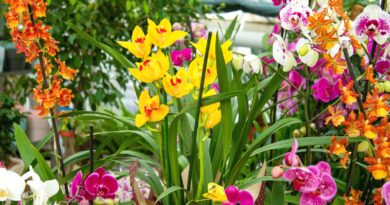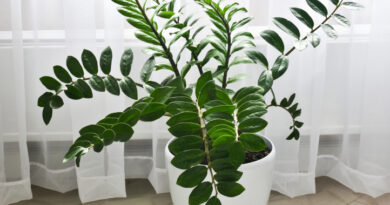Our Favorite Colorful Houseplants for Dreary Winter Days
The word “houseplant” is funny, as any plant can live in a house for some time. The term regularly refers to those species that perform well for extended periods indoors. Some may live their entire lives in your home without ever needing to grow outside!
Most of these plants flower in spring. The lengthening days and warming temperatures are signals that wake up dormant species. Though most species prefer blooming in the spring, some do so during winter! Those houseplants that like warm temperatures and bloom in winter are ideal for your home, as they provide enchanting and colorful flowers throughout the cold months.
Aside from stunning flowers, colorful foliage attracts us to these special specimens. We include our favorite vines, perennials, and shrubs with lush, colorful foliage. Whether you’re a beginner or an advanced houseplant cultivator, there’s a colorful option on this list that’ll brighten your home in winter. Let’s start with the flowering species!
Amaryllis


Amaryllis bulbs are one of the only bulbs you can grow indoors year-round! They’re perfect for a bright windowsill with indirect light. They’ll offer stunning blooms and strappy green leaves during the winter months.
Though amaryllis bulbs excel under indoor conditions, they’ll also thrive in full sun or partial shade outdoors in USDA hardiness zones 7 through 10. As summer approaches, they’ll prepare for dormancy and suck energy from their leaves. You may leave them outdoors in these warm zones, or unbury them for indoor storage.
Store dormant amaryllis bulbs for eight to ten weeks indoors, giving them a cool, dark location. Then, pot them up five weeks before you want blooms. If you want flowers by Christmastime, move them under bright filtered light by late August or early September.
Persian Cyclamen


Low-growing spreaders, cyclamen are lovely perennial ground covers that excel outdoors in shady gardens. Because they tolerate cooler temperatures than most other houseplants, these colorful beauties are perfect for chilly windowsills and spots near cold winter drafts. Other species are best outdoors, while the Persian cyclamen grows well inside.
Like amaryllis, cyclamen enter summer dormancy and bloom during the winter months. They’ll need less water and a dark location while dormant. They’ll wake up during autumn as days shorten and temperatures cool. Increase watering so the soil is moist, and water only after the soil dries on top.
Cyclamen may bloom for months! Deadhead spent blossoms to encourage more to grow. Incredibly common, you can find these tuberous perennials at plant nurseries, garden centers, and online stores.
Christmas Cactus


Every home should have a Christmas cactus for the wintertime! Erupting into bloom as days shorten in winter, this epiphytic plant is perfect for dull rooms in need of color. Its bright pink, purple, or red blooms contrast beautifully with the green, fleshy foliage.
When left near a windowsill with natural light, a Christmas cactus will bloom every year around the holidays. In dark rooms or those with grow lights, the perennial may have trouble blooming properly. It’s sensitive to daylengths, producing flower buds as days shorten and nights lengthen.
To ensure your cactus flowers, grant it 13 hours or more of uninterrupted darkness. Artificial light, grow lights, and other bright sources may interfere with the plant’s natural process. Ensure these extraneous light sources are off, or move your potted specimen into a dark closet every night for 13 hours. After flower buds form, you may resume normal care.
Poinsettia


Poinsettias are the perfect winter houseplants with colorful flowers. They grace the shelves of every big-box department store during the holidays. Their red flowering bracts and green leaves create the perfect duo, matching the deep reds and forest greens that are abundant during Christmas.
Though most people throw the plants away after they finish blooming, you can keep yours indoors the whole year! Save waste from the landfill and keep it in a pot. The poinsettia will continue offering lush foliage and flowers until winter turns into spring.
Your poinsettia needs warm temperatures, little water, and bright light. Water it once the soil dries on top, and keep the leaves out of harsh direct sun rays. Once new growth appears, apply a regular monthly dose of a balanced organic fertilizer.
Cape Primrose


Like normal primroses, cape primroses grow fuzzy green leaves and lush blooms. They’ll flower up to ten months a year, offering endless blooms for little in return. Drought-hardy, low light tolerant, and easily propagated, colorful cape primroses are essential for the winter-flowering houseplant collector.
My all-time favorite variety is ‘White Ice’ from the Ladyslippers™ collection. It sports white tubular flowers with purple splotching on the throats. The petals open flat at their ends, creating a structure similar to primrose flowers.
Whether you opt for ‘White Ice’ or a similar cultivar, grant your specimen bright filtered light in a location away from cold or hot drafts. If your home is too dark for cape primrose, consider adding grow lights! These plants love growing offset from artificial light.
Pin-Stripe Calathea


Though calatheas can be fussy, this one excels inside! It’s tolerant of average humidity levels, unlike other houseplants with the common name calathea. This pin-stripe type sends out oval forest-green leaves with thin pink stripes.
Pin-stripe calathea requires filtered water to grow best. Tap water won’t do, as the extra minerals and salts cause a buildup in the soil around the roots. New foliage will grow a crusty, sappy substance that oozes from the leaf undersides. Wipe the substance off and wash the salts away with filtered water.
If leaf browning continues after you stop using tap water, the plant may not have enough humidity. Use a pebble tray, a humidifier, or a daily mister to raise humidity levels.
Coleus


Coleus grows throughout tropical and subtropical regions worldwide! These colorful specimens also ideal houseplants, growing well in a wide range of conditions and staying pretty during the winter. Some new varieties prefer direct sunlight, while others thrive in filtered or indirect light.
Like cape primroses, these perennials perform surprisingly well underneath grow lights. If your home is too dark, place your plants a few inches beneath the lights. A general rule of thumb is to look at the leaf color—varieties with red or maroon foliage prefer more sunlight, while green and yellow types thrive with more shade.
Coleus comes in all shapes, sizes, and colors. Find varieties with variegation, others with giant leaves, and some with dwarf structures. A classic type is ‘French Quarter.’ It sports leaves with pink centers that evolve into maroon and green on the edges.
Croton


Crotons add colorful charm to tropical gardens. They’re evergreen shrubs with leaves that look unlike any other plant! Varieties display reds, greens, yellows, pinks, purples, and combinations of all colors. They’re a favorite of houseplant breeders, meaning you can find dozens of bright varieties no matter where you live.
Though crotons are colorful, they require brighter light than most other plants. Ensure they receive filtered sunlight for most of the day, though safeguard them from harsh direct rays. They require constant humidity, thriving with humidifiers or pebble trays in arid regions.
Without sufficient humidity, plants may dramatically drop their leaves and stop growing. Do not worry—your plant is not dead yet! Try increasing the humidity until your specimen recovers. Wait to water until the soil surface dries, as overwatering may lead to root rot.
Burmese Evergreen


Burmese evergreen grants lush, tropical flair no matter where it grows. It thrives best with filtered light, though it’ll tolerate some direct sunlight during the growing season. It’ll perform better in low humidity than calatheas or crotons, living for many years with little care.
Happy, mature Burmese evergreens may form blooms as days shorten in fall and winter. Cut them off so the plants can divert energy into producing more luscious leaves. You may leave them on if you like how they look! They’re small but pretty.
My favorite Burmese evergreen is ‘Curtisii.’ It forms stripes of creamy gray that stand out on the dark green leaves. Another cool type to try is ‘Ernesto’s Favorite.’ Instead of stripes, it has leaves with gray centers and deep green margins.
Philodendron ‘Pink Princess’


‘Pink Princess’ is a favorite philodendron for good reason! Its dark green and maroon foliage exhibits occasional splashes of bright pink. The pink is unlike any other pink you’ve seen on a houseplant; it almost looks fake! Not fake, the ‘Pink Princess’ grows throughout the U.S. in hundreds of homes.
If your friend has this plant, ask them for a cutting! It’s incredibly expensive at the store, as it’s a rare, slow-growing variety. If you’d rather not pay exorbitant fees for a plant, consider trying one of these other colorful philodendrons. ‘Prince of Orange’ exhibits orange leaves that turn lime green. ‘Burgundy Princess’ has all maroon leaves that stand out against white walls.
Pothos


Pothos is the ideal houseplant! It sprouts new leaves and vines in incredibly low-light settings. It reaches for the light, using its energy to drape and creep closer to windows and grow lights. If left alone, the vines may reach 40 feet or longer!
Pothos is supreme inside houses because of its growth habits. It naturally sprouts in tropical regions, climbing trees like monstera vines. As the vines reach the tree canopy, they evolve into their mature flowering form. Pothos sprout giant leaves, flowers, and fruits in tropical climates.
In your home, the vine will stay in its immature creeping form. Try ‘N’Joy’ for creamy white and dark green variegation. Opt for ‘Neon’ if you prefer all yellow leaves, and the species type Epipremnum aureum if you like yellow-green variegation. These are but some of the dozens of colorful pothos varieties you have to choose from!




